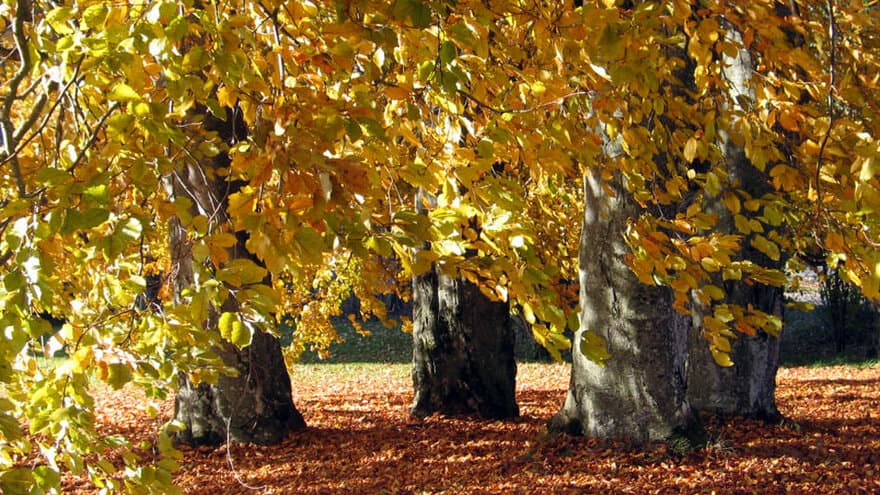NMBU is Norway’s smallest university, but it has one of the largest and most beautiful park facilities. This is connected to the focus on nation-building when the Higher Agricultural School at Ås was established and the institution’s tradition in garden art history and horticulture.
Find all the plants in The Garden Explorer NMBU
The Men behind the Facility
Bergstrøm taught garden art from the 1880s; he designed and created the courtyards and gardens around the Tun buildings and Svanedammen. During the major expansion around 1900, Misvær took over from Bergstrøm, expanding the park facilities and creating romantic settings between the Tun buildings. In 1920, the construction of Tårnbygningen began, and Olav Leif Moen took over the work on the park. He had been a student of Misvær and had education from NLH and foreign schools. He was appointed as an associate professor for horticultural education and was also the park manager. At that time, there were close ties between park operations and horticultural education.

Axes, Lines, and Secret Rooms in the Park
Moen designed strict axes and sightlines. These are clearly visible in the area between Cirkus, Tårn, and Ur. The sightline from Tårnbygningen to the chimney at the Center for Climate-Regulated Plant Research is a line that blooms every spring.

Moen was a master at creating surprising spaces or small gardens in the park. Everyone should take a walk to search for these. A semicircular “classroom” in the beech forest south of Tårnbygningen is one example.
Moen continued his predecessor’s idea of the park as a public park. It was, and still is, a gift to the people of Ås, employees, students, and visitors. Park tours are regularly arranged; participate in these to become well acquainted with the park.
What has disappeared over the past 150 years?
Several stairs and paved steps in the area around and on the main lawn have been removed because they became worn out and eventually destroyed. From 2015 to 2020, the area was restored and re-established.
In a park, some trees will always need to be taken down and new ones planted. This creates a living park. Trees are felled and new ones planted every year.

Tuntreet, The Tun Tree, was planted in 1864 when it was five years old. Tuntreet, which is a linden, was thus 150 years old in 2009. This is a great age for a Norwegian linden. Tuntreet has been struck by lightning several times. At one point, it was considered for removal, but large support rods were chosen instead. These are still in place in the crown.
"Universitetslunden” - A new alternative courtyard tree was planted in 2005 when the Norwegian School of Agriculture (NLH) became a university. These are seven red maple trees (blood maple) planted in a ring. They are to be pruned so that they eventually grow together and form a common crown. Crown Prince Haakon Magnus unveiled “Universitetslunden,” which was designed by Professor Karsten Jørgensen (ILP).
One of the tallest coniferous trees in the park is a Coast Douglas-fir, Pseudotsuga menziesii, planted around 1880. (Pinaceae).
Open stormwater managment
Niagarafallene got its name after the world’s largest waterfall because it is the world’s smallest waterfall. The part of the park that stretches from Andedammen down towards the Jordafagsbygningen and Urbygningen was designed by Moen and came into being around 1940.
Around 2020, the water flow was opened up more than before. You can follow the water from Andedammen down to the Veterinary Building.

The Duck Pond or the Swan Pond? On old maps, it is named The Swan Pond. Colloquially, it is called The Duck Pond. Officially, it is named The Swan Pond.

The red benches in front of Urbygningen were designed by Olav Leif Moen. They were built in a carpentry workshop in Sweden and placed in the park in 2008.
Old Roads: NMBU has roads from the late 1700s on the premises. The steep hill from the KA building up to the church avenue is part of the Fredrikshald royal road.
Stoltenbergalléen: In 1780, Provost Stoltenberg ordered the establishment of an avenue on this hill. Provost Stoltenberg was the great-great-great-grandfather of former Prime Minister Jens Stoltenberg and Camilla Stoltenberg, Director of the Norwegian Institute of Public Health (FHI). This hill is referd to as Åsbakken today.
Bjørn Anders Fredriksen, who holds a doctorate on the park at NMBU and was the park manager from 2015 to 2022, ensured that the avenue in Åsbakken was supplemented with new trees in 2016 and 2017. At the same time, the road route down to Urbygningen was altered so that the avenue could be planted all the way to Urbygningen. This part of the avenue was removed when the Isotope Building was constructed in the 1960s. Originally, the avenue led down to Falsen’s courtyard at Vollebekk, where the Falsen Monument stands today.
Falsenstøtta, The Falsen Monument
The Higher Agricultural School at Ås was originally established on state farms, including a district judge’s farm and a parsonage. Christian Magnus Falsen was the district judge and lived on one of the farms. It was here that he wrote the draft for the constitution in 1814. In 1864, a monument was erected near the farm with a small park around it. This installation was not part of the school’s park facilities.
Student traditions
Painting of the house in The Swan Pond is relatively recent.
The original battles was started because the exclusive student association “The Association for the Promotion of Emigration” annually tried to emigrate to the island, while “The Tomcats” for unknown reasons tried to stop them. Today, it is the latter association that emigrates.
Kurt Stille's memorial race
The choir Lærken annually organizes the “Kurt Stille Memorial Race” on skates. Kurt Stille is Denmark’s only speed skater of all time. He started as a popular recreational skater but became an internationally strong long-distance skater. Today, he is a very skilled cross-country skier. He always attends the event.
